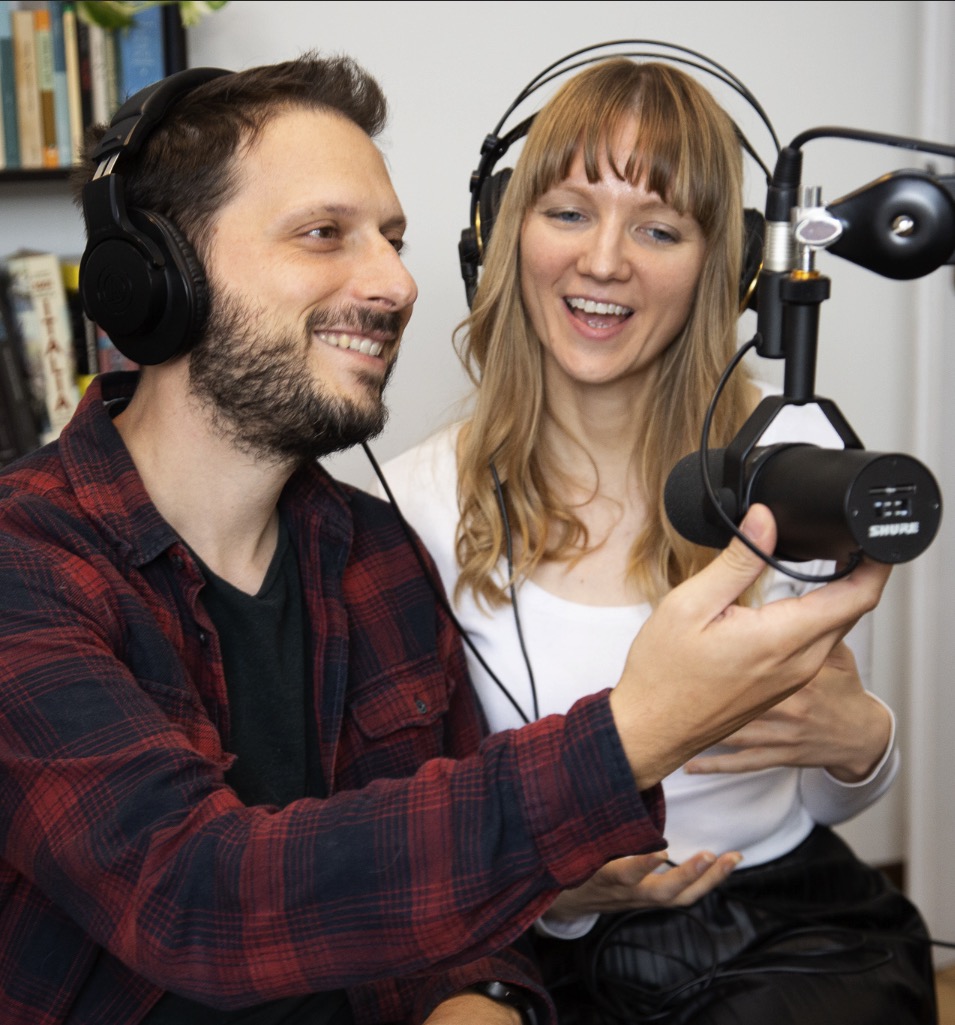They can’t be serious, can they?
Talking at 200 mph, mushing words together or leaving them out entirely.
It's as if those smug native speakers got together one day and decided to garble their words, just to stop us poor language learners from figuring out what they’re saying.
If you could read the same words you might understand, but listening? It's a whole other level.
If only native speakers came with subtitles in real life!
One thing that makes real-world listening so hard is that textbooks and audio courses spoon-feed us a simplified version of the language. Sure, they make life easier at the beginning, but they don’t do a very good job at preparing us for how people actually talk. Which can lead to two things:
 On the Easy Languages series, the presenters interview people on the street, so you can get used to hearing real, spontaneous speech. There are subtitles in the target language and in English, which makes them perfect for our next activity...
On the Easy Languages series, the presenters interview people on the street, so you can get used to hearing real, spontaneous speech. There are subtitles in the target language and in English, which makes them perfect for our next activity...
Now you’ve got your videos and subtitles sorted, let’s learn how to use them.
- When we hear people speaking in real life, we don’t have a clue what’s going on.
- When we talk, we sound stilted and unnatural.
- Give your listening skills a boost
- Sound more like a native speaker
- Stop falling off the language-learning wagon
Why learn a language by watching TV and films?
What I hear = how I talk
When I meet French people, sometimes they’re surprised to learn that I’ve never lived in France. My accent is pretty decent, my speech is littered with native sounding interjections, and on a good day, I can sit amongst a group of French people and follow (most of) their conversation. How? I’ll let you in on my secret, but you’ve got to promise not to laugh, OK? La téléréalité. That is, reality TV in French. Before you make a dash for the back button, don’t worry. If you like your TV a little more highbrow, I’m not suggesting you do the same. In fact, learning a language with reality TV has its downsides too - namely, that my vocabulary is quite limited (reality TV stars aren’t exactly known for their eloquence). The important thing to learn from this is that speaking styles reflect the things we listen to. Reality TV = natural speaking style but with a limited vocabulary. My French = natural speaking style but with a limited vocabulary. When I started speaking Spanish, my boyfriend used to laugh because I spoke with really dramatic intonation, thanks to too many telenovelas. More recently, I’ve picked up lots of Mexican slang and football vocabulary because I’ve been watching Mexican football drama Club de Cuervos.TV and films help you speak naturally and understand more
If you only listen to those slow and stilted dialogues in textbooks, you’ll probably end up speaking in a slow and stilted way. Alternatively, if you listen to lots of realistic conversations in TV series and films, over time, you’ll start speaking in a more natural way. The same goes for understanding: if you only listen to learner materials, you’ll get used to hearing a version of the language that’s been watered down for gringos. You might get a shock when you hear people using it in real life! On the flip side, if you get used to hearing realistic dialogues in TV series and films (even if it’s tricky at first!), you’ll be much better equipped to follow conversations in the real world. I’m not suggesting you try to learn a language entirely by watching TV and films. Learner materials like textbooks and audio courses have their place in a language learner’s toolkit. And speaking practice is essential. Foreign-language TV series and films are like handy supplements that can help you bridge the gap between learner materials and how people actually talk.What if I don’t understand anything?
When people think of learning a language by watching TV, they sometimes imagine learning through osmosis - the idea that if you listen to a stream of undecipherable syllables for long enough, it will eventually start to make sense. But it doesn’t work like that. To learn, you have to understand first. Once you get to a high(ish) level where you can pick out a fair amount of what the characters are saying, you can learn a lot from just sitting back and listening. What if you’re not there yet? Before that, if you want to learn a language by watching TV and films, it’s important to do activities that’ll help you understand the dialogues. The 5 activities in this article will help you do just that.How to learn a language by watching TV and films: what you’ll need
First, you’ll need a film, TV series or YouTube video with two sets of subtitles: one in the language you’re learning, and one your native language. This used to be tricky, but with YouTube and Netflix it’s getting easier and easier to find videos which are subtitled in multiple languages. Aim for videos where people speak in a modern and natural way (i.e. no period dramas). One of my absolute fave series for this is Easy Languages on YouTube. The presenters interview people on the street, so you get used to hearing natives speak in a natural and spontaneous way. What’s more, the videos are subtitled both in the target language and in English. Easy German and Easy Spanish are particularly good as they both have their own spin-off channels where they add fun and interesting videos a couple of times a week. If you’re a beginner and you find these kinds of videos overwhelming (too many new words and grammar points), they also have a “super easy” series that you can use to get started. On the Easy Languages series, the presenters interview people on the street, so you can get used to hearing real, spontaneous speech. There are subtitles in the target language and in English, which makes them perfect for our next activity...
On the Easy Languages series, the presenters interview people on the street, so you can get used to hearing real, spontaneous speech. There are subtitles in the target language and in English, which makes them perfect for our next activity...Now you’ve got your videos and subtitles sorted, let’s learn how to use them.
5 smart ways to learn a language by watching TV and films
Write what you hear
One super task to boost your listening skills is to use the videos as a dictation:- Listen to very small pieces of the video (a few seconds each) and write down what you hear.
- Listen several times until you can’t pick out anymore.
- Compare what you wrote against the subtitles.
- Look up new words in a dictionary and write them down so you can review them later.
- In spoken English, “do you” often sounds like “dew”, and want sounds like “one”. So the phrase “do you want it” is pronounced like “dew one it”
- In spoken French, “ce que” is pronounced like “ske” and “il y a” is pronounced like “ya”
Translate it
Another invaluable task is to translate small passages into your native language and back into the language you’re learning. After you’ve done this, you can check what you wrote in your target language against the original subtitles. Ideally, you should translate the passage into your native language one day and back into your target language the day after, so that you have to use your existing knowledge about grammar and vocabulary to recreate the dialogue (rather than just relying on memory). This technique works because it gives you the chance to practice creating sentences in your target language, then compare them against native speaker sentences. In this way, you'll be able to see the gap between how you use the language and how the experts (the native speakers) do it. This will help you learn to express ideas and concepts like they do. Comparing your performance to the experts’ and taking steps to close the gap is a key element of deliberate practice, a powerful way to master new skills which is supported by decades of research.Get into character
One fun way to learn a language from TV and films is to learn a character’s part from a short scene. Choose a character you like, and pretend to be them. Learn their lines and mimic their pronunciation as closely as possible. You can even try to copy their body language. This is a great method for a couple of reasons:- It’s an entertaining way to memorize vocabulary and grammar structures.
- By pretending to be a native speaker, you start to feel like one - it’s a fun way to immerse yourself in the culture.
Talk about it
A great way to improve your speaking skills is the keyword method:- As you watch a scene, write down keywords or new vocabulary.
- Once you’ve finished watching, look at your list of words and use them as prompts to speak aloud for a few minutes about what you just saw.




